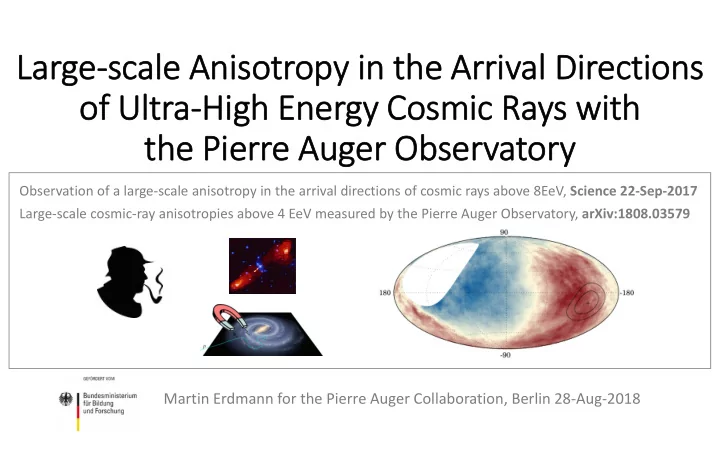

Large‐scale Anisotropy in the Arrival Directions of Ultra‐High Energy Cosmic Rays with the Pierre Auger Observatory Observation of a large‐scale anisotropy in the arrival directions of cosmic rays above 8EeV, Science 22‐Sep‐2017 Large‐scale cosmic‐ray anisotropies above 4 EeV measured by the Pierre Auger Observatory, arXiv:1808.03579 Martin Erdmann for the Pierre Auger Collaboration, Berlin 28‐Aug‐2018
World‘s largest Calorimeter Pierre Auger Observatory 10 km Water Cherenkov detectors 60 km NASA 50 km Martin Erdmann RWTH Aachen University 2
Observation of a large‐scale anisotropy in the arrival directions of cosmic rays above 8EeV, Science 22‐Sep‐2017 , Vol. 357, Iss. 6357, p. 1266 Dipolar anisotropy in arrival directions Cosmic ray arrival direction dec = declination RA = right ascension www.astro.ufl.edu Martin Erdmann RWTH Aachen University 3
Science 22‐Sep‐2017 Departure from isotropic arrival [E>8EeV] First‐harmonic Fourier components 5 measurement time First clear anisotropy signal Martin Erdmann RWTH Aachen University 4
Science 22‐Sep‐2017 Reconstructing the 3dim. Dipole Combine 2 first‐harmonic Fourier analyses Equatorial coordinates Dipole components Right ascension perpendicular parallel Galactic coordinates Azimuth of shower direction Amplitude 6.5 (+1.3/‐0.9) % Martin Erdmann RWTH Aachen University 5
Large‐scale cosmic‐ray anisotropies above 4 EeV measured by the Pierre Auger Observatory, arXiv:1808.03579 Galactic origin? Messages • Dipole directions close to Galactic center • Dipole amplitudes too large for Galactic cosmic‐ray origins (>0.8) Model • Sources continuous in Galaxy, density as luminous Unlikely to arise from Galactic component matter (gray) • Cosmic rays: various rigidities R=E/Z propagated through Galactic magnetic field (JF12, PT11) • Flux weight by integrating matter density along path through Galaxy Martin Erdmann RWTH Aachen University 6
arXiv:1808.03579 Extragalactic origin: Galactic Magnetic Field Messages • mild changes: dipole direction & amplitude • extragalactic dipoles at positive Galactic longitudes align closer to inner spiral arm, R=E/Z = 4,8,16,32 EV opposite half to outer spiral arm Model effect of Galactic Magnetic Field Dipole most likely of extragalactic origin • Directional change of extragalactic dipole • Line color: suppression of dipole amplitude • Arrows start at extragalactic directions → reconstruct on Earth for different CR rigidities Martin Erdmann RWTH Aachen University 7
arXiv:1808.03579 Examples extragalactic origins example: 2MRS (<100 Mpc) flux weighted dipole plus galactic magnetic field deflections Also possible: diffusive propagation from powerful sources in a few nearby galaxies Martin Erdmann RWTH Aachen University 8
arXiv:1808.03579 Energy dependence of dipole direction Measurements • Direction of dipole for different energy bins • Gray symbols: 2MRS galaxy catalog (<100 Mpc) • Cross symbol: direction of flux‐weighted 2MRS dipole Interpretation • no clear trend in change of dipole direction as function of energy Martin Erdmann RWTH Aachen University 9
arXiv:1808.03579 Energy dependence of dipole amplitude Measurement • Growing amplitude of dipole with increasing energy Interpretation • Smaller deflections of cosmic rays at higher rigidities • Increased attenuation for cosmic rays from distant sources, increased relative flux from nearby sources 8 → more anisotropic Martin Erdmann RWTH Aachen University 10
arXiv:1808.03579 Combine Dipolar & Quadrupol contributions? Observations • Quadrupolar components not statistically significant • Dipolar components consistent with dipole‐only results Martin Erdmann RWTH Aachen University 11
Conclusion Observation Dipolar anisotropy with > 5 significance ! • 5 • Dipole amplitude increases with cosmic‐ray energy Interpretation • Unlikely of Galactic origin • Easily explained by extragalactic origin • Not yet clear: dipolar anisotropy may • arise from diffusive propagation from powerful sources in few nearby galaxies • reflect known anisotropy in distribution of galaxies within few hundred Mpc Martin Erdmann RWTH Aachen University 12
Amplitude & Phase Martin Erdmann RWTH Aachen University 13
Recommend
More recommend